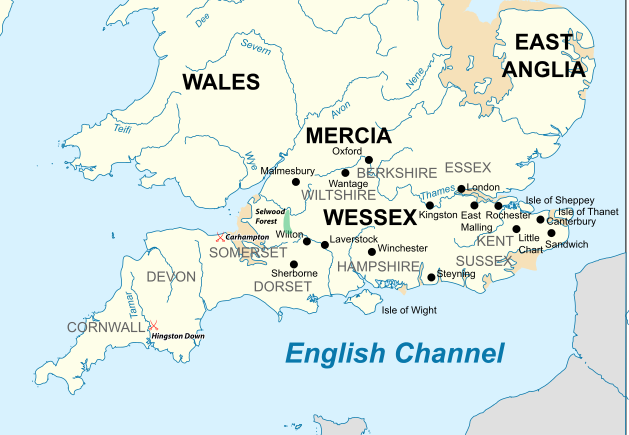

Æthelwulf had had a document drawn up between 856 and 858 in which he set out his wishes of succession. The document has not survived but details of it are included in Asser’s writings which indicating that the kingdom should be divided with Æthelbald inheriting what was seen as Wessex and the lands in modern day Cornwall and Devon, with his two youngest brothers Æthelred and Alfred succeeding him if he died childless. Æthelbehrt, the second son was to inherit the lands to the east, in Kent, Essex, Sussex and Surrey. The land held by Alfred's relatives can be referred to as West Saxon territory.
|
Æthelwulf died in January 858 and the land was divided as his will specified, however Æthelbald died only two years later, in 1860, childless from his marriage to his father’s widow, Judith. As the next eldest child Æthelred would have been expected to take over control of Wessex when Æthelbald died, however Æthelberht succeeded to the whole kingdom, amking him king of both Wessex and the lands he already held to the east. There appears that there was an understanding that Æthelred followed by Alfred would succeed in turn on the death of Æthelberht. Æthelberht died in 865, also without an heir, with Æthelred succeeding him. Asser makes it clear in his account that Alfred was seen as the heir apparent and that arrangements were made so that when one of the brothers died any of their children would be generously provided for, but the succession would pass to the surviving brother and thereafter any children they might have.
After Easter in 871 Æthelred died possibly from wounds he received at a battle
in the vicinity of Marton, Wiltshire. As Wessex was in dire need of
leadership it would have been an unwise move to ignore Alfred and have
one of Æthelred's young sons (Æthelwold and Æthelhelm) take the throne.
The agreement and the perceived great threat from the
Vikings meant that Alfred succeeded him without being challenged. |
 Map showing the land held by Wessex at the end of the 9th Century Philg88, Southern British Isles 9th century, CC BY 4.0 |